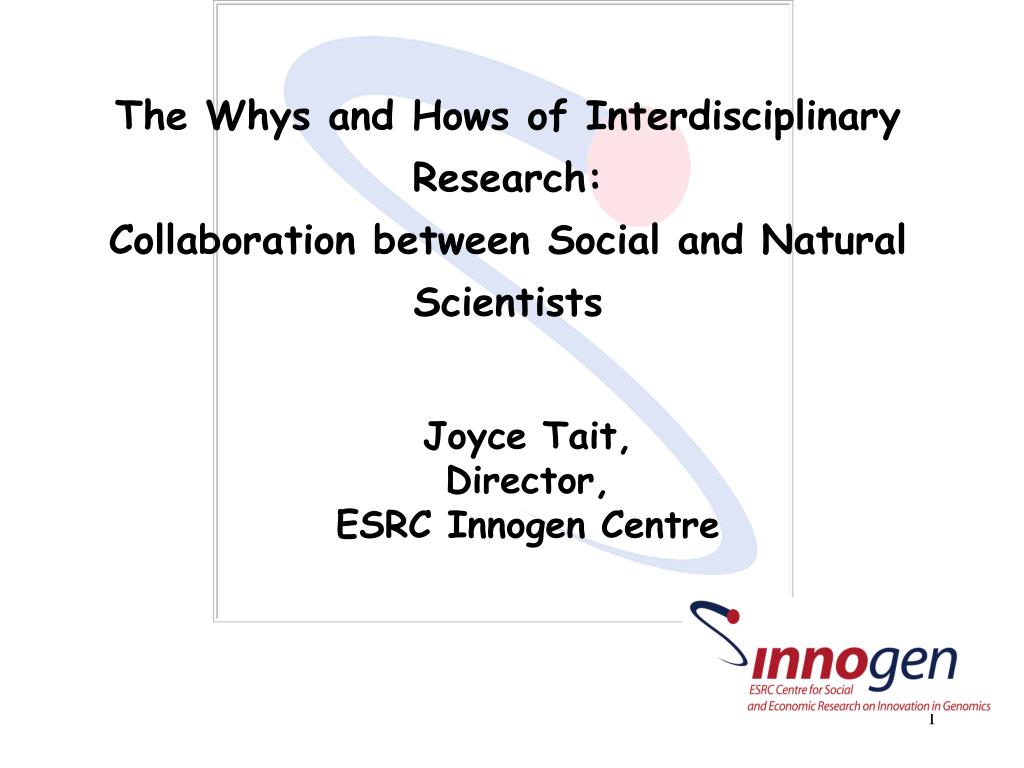The Importance Of Interdisciplinary And Transdisciplinary Approaches In Research And Practice

Table of Contents
Defining Interdisciplinary and Transdisciplinary Research
What is Interdisciplinary Research?
Interdisciplinary research integrates knowledge, methods, and perspectives from multiple disciplines to address a shared problem. It involves scholars from different fields working together, but maintaining their disciplinary identities. The focus is on combining existing knowledge and methodologies to create a more holistic understanding and solution.
-
Examples of interdisciplinary research:
- Studying the impact of climate change on coastal communities, combining expertise in biology, oceanography, sociology, and economics.
- Developing new cancer treatments, integrating knowledge from oncology, chemistry, and biomedical engineering.
- Analyzing the spread of misinformation online, drawing on expertise from computer science, sociology, and psychology.
-
Advantages of interdisciplinary research:
- Provides broader perspectives and deeper understanding of complex problems.
- Fosters innovative solutions by combining different theoretical frameworks and methodological approaches.
- Enhances the rigor and validity of research findings through cross-validation and triangulation.
What is Transdisciplinary Research?
Transdisciplinary research goes beyond the integration of disciplines; it transcends disciplinary boundaries to address real-world problems. It actively involves stakeholders beyond the academic realm, such as community members, policymakers, and practitioners. The goal is to co-create knowledge and solutions that are relevant, impactful, and applicable to real-world contexts.
-
Examples of transdisciplinary research:
- Designing and implementing community-based health interventions, involving researchers, healthcare providers, community leaders, and residents.
- Developing sustainable urban planning strategies, engaging architects, engineers, urban planners, sociologists, and community members.
- Creating educational programs that address the needs of diverse learners, collaborating with educators, psychologists, social workers, and parents.
-
Advantages of transdisciplinary research:
- Increases the relevance and impact of research findings by ensuring they address real-world needs and concerns.
- Enhances the transferability of knowledge and solutions from research settings to practical applications.
- Promotes greater equity and social justice by involving diverse stakeholders in the research process.
Benefits of Interdisciplinary and Transdisciplinary Approaches
Enhanced Problem-Solving
Interdisciplinary and transdisciplinary approaches significantly enhance problem-solving capabilities. By integrating diverse perspectives and expertise, researchers can gain a more comprehensive understanding of complex issues, identify previously overlooked factors, and develop more innovative and effective solutions.
- Examples: A transdisciplinary approach to addressing food insecurity might involve agricultural scientists, economists, nutritionists, and community organizers to develop sustainable and culturally appropriate solutions tailored to specific community needs.
Increased Innovation
The combination of different disciplinary lenses fosters creativity and drives innovation. Interdisciplinary and transdisciplinary research often leads to the development of new methodologies, technologies, and theoretical frameworks that would not be possible within a single discipline.
- Examples: The development of new materials often requires a collaborative effort between chemists, physicists, and engineers. Advances in artificial intelligence benefit from collaborations between computer scientists, mathematicians, and cognitive psychologists.
Improved Communication and Collaboration
Successful interdisciplinary and transdisciplinary projects require effective communication and collaboration. Researchers need to develop shared understanding, establish clear roles and responsibilities, and create mechanisms for regular communication and feedback.
- Strategies for fostering effective communication and collaboration:
- Establish shared goals and objectives from the outset.
- Define clear roles and responsibilities for each participant.
- Implement regular communication channels, such as meetings, email, and shared online platforms.
- Employ collaborative writing and editing tools.
- Develop shared vocabulary and understanding of different terminologies.
Challenges of Interdisciplinary and Transdisciplinary Research
Overcoming Communication Barriers
One of the key challenges of interdisciplinary and transdisciplinary research is overcoming communication barriers between disciplines. Researchers from different fields often use different terminologies, methodologies, and theoretical frameworks, which can lead to misunderstandings and communication breakdowns.
- Strategies for overcoming communication barriers:
- Develop a shared vocabulary and understanding of key concepts.
- Provide training in interdisciplinary communication and collaboration.
- Establish clear communication protocols and expectations.
- Encourage active listening and respectful dialogue.
Managing Diverse Perspectives and Priorities
Integrating diverse viewpoints and coordinating efforts across multiple disciplines and stakeholders can be challenging. Different disciplines may have different priorities, methodologies, and timelines, which can lead to conflicts and disagreements.
- Strategies for managing diverse perspectives:
- Employ consensus-building techniques to reach shared agreements.
- Develop conflict resolution strategies to address disagreements effectively.
- Establish clear decision-making processes and procedures.
- Foster a culture of mutual respect and understanding.
Securing Funding and Resources
Obtaining funding for interdisciplinary and transdisciplinary projects can be more difficult than for single-discipline projects. Granting agencies may require more complex grant proposals and may be less familiar with the unique challenges and opportunities presented by interdisciplinary and transdisciplinary research.
- Strategies for securing funding:
- Emphasize the unique value proposition of the research project.
- Build strong collaborations with researchers from different disciplines and stakeholders.
- Develop a compelling narrative that highlights the potential impact of the research.
- Seek funding from multiple sources.
Conclusion
In conclusion, interdisciplinary and transdisciplinary approaches are essential for addressing the complex challenges facing society today. They offer significant benefits, including enhanced problem-solving, increased innovation, and improved communication and collaboration. While challenges exist, such as communication barriers and securing funding, these can be overcome through careful planning, effective communication strategies, and strong collaborations. Embrace interdisciplinary research to unlock innovative solutions; promote transdisciplinary collaboration for impactful results. Integrate diverse perspectives to enhance your research projects. Champion collaborative research to address complex societal issues. By adopting and promoting interdisciplinary and transdisciplinary approaches, we can unlock the potential for a more sustainable and equitable future.

Featured Posts
-
 Suncoast Searchlight Increased Demand For Mental Healthcare Exacerbates Resource Shortages
May 19, 2025
Suncoast Searchlight Increased Demand For Mental Healthcare Exacerbates Resource Shortages
May 19, 2025 -
 Suncoast Searchlight Resource Allocation Challenges In The Face Of Growing Mental Health Needs
May 19, 2025
Suncoast Searchlight Resource Allocation Challenges In The Face Of Growing Mental Health Needs
May 19, 2025 -
 Ufc Vegas 106 Burns Vs Morales When Where And Whos Fighting
May 19, 2025
Ufc Vegas 106 Burns Vs Morales When Where And Whos Fighting
May 19, 2025 -
 U Conn Legend Paige Bueckers Inducted Into Huskies Of Honor
May 19, 2025
U Conn Legend Paige Bueckers Inducted Into Huskies Of Honor
May 19, 2025 -
 Justice For Stolen Dreams The Struggle Of A Restaurant Owner
May 19, 2025
Justice For Stolen Dreams The Struggle Of A Restaurant Owner
May 19, 2025
